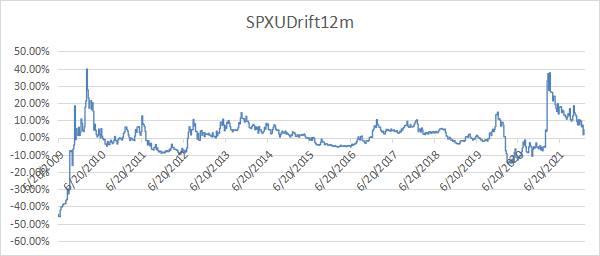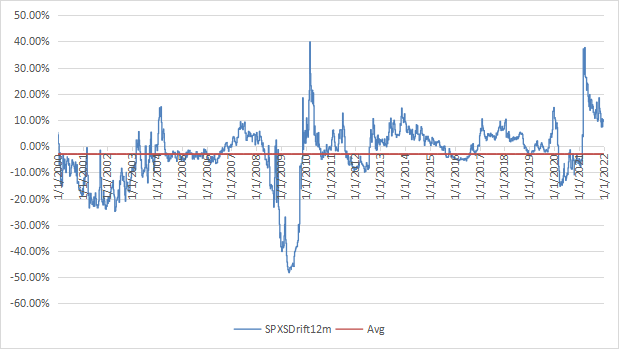[ad_1]
hatman12/iStock via Getty Images
The ProShares UltraPro Short S&P 500 ETF (SPXU) is one of the most popular instruments to short the broad market for trading or hedging purposes. However, its daily -3X leverage factor is a source of drift. It must be closely monitored to detect changes in the drift regime. This article explains what “drift” means, quantifies it in more than 20 leveraged ETFs, shows historical data, and finally concludes about the current market conditions. The analysis is also valid for the Direxion Daily S&P 500 Bear 3x Shares ETF (SPXS), which tracks the same index with the same factor and has an almost identical behavior.
Why do leveraged ETFs drift?
Leveraged ETFs often underperform their underlying index leveraged by the same factor. An ETF’s decay may have four reasons: beta-slippage, roll yield (when futures are used), tracking errors, and management costs. Beta-slippage is the main one for equity leveraged ETFs. However, when an asset is in a steady trend, leveraged ETFs can bring an excess return instead of a decay. You can follow this link to learn more about beta-slippage.
Monthly and yearly drift watchlist
There is no standard or universally recognized definition for the drift of a leveraged ETF. Some are quite complicated. Mine is simple and based on the difference between the leveraged ETF performance and Ñ times the performance of the underlying index on a given time interval if Ñ is the leveraging factor. Most of the time, this factor defines a daily objective relative to an underlying index. However, some dividend-oriented leveraged products have been defined with a monthly objective (mostly defunct high-yield ETNs sponsored by Credit Suisse and UBS: CEFL, BDCL, SDYL, MLPQ, MORL…).
First, let’s start by defining “Return”: it is the return of a leveraged ETF in a given time interval, including dividends. “IndexReturn” is the return of a non-leveraged ETF on the same underlying asset in the same time interval, including dividends. “Abs” is the absolute value operator. My “Drift” is the drift of a leveraged ETF normalized to the underlying index exposure in a time interval. It is calculated as follows:
Drift = (Return – (IndexReturn x Ñ))/Abs(Ñ)
“Decay” means negative drift. “Month” stands for 21 trading days, “year” for 252 trading days.
|
Index |
Ñ |
Ticker |
1-month Return |
1-month Drift |
1-year Return |
1-year Drift |
|
S&P 500 |
1 |
SPY |
-5.51% |
0.00% |
21.18% |
0.00% |
|
2 |
SSO |
-11.12% |
-0.05% |
42.32% |
-0.02% |
|
|
-2 |
SDS |
11.28% |
0.13% |
-35.81% |
3.28% |
|
|
3 |
UPRO |
-16.57% |
-0.01% |
65.61% |
0.69% |
|
|
-3 |
SPXU |
16.87% |
0.11% |
-49.65% |
4.63% |
|
|
ICE US20+ Tbond |
1 |
TLT |
-3.73% |
0.00% |
-4.99% |
0.00% |
|
3 |
TMF |
-11.61% |
-0.14% |
-20.81% |
-1.95% |
|
|
-3 |
TMV |
10.31% |
-0.29% |
1.17% |
-4.60% |
|
|
NASDAQ 100 |
1 |
QQQ |
-9.32% |
0.00% |
13.14% |
0.00% |
|
3 |
TQQQ |
-27.04% |
0.31% |
27.33% |
-4.03% |
|
|
-3 |
SQQQ |
28.67% |
0.24% |
-45.07% |
-1.88% |
|
|
DJ 30 |
1 |
DIA |
-3.57% |
0.00% |
18.16% |
0.00% |
|
3 |
UDOW |
-10.59% |
0.04% |
55.06% |
0.19% |
|
|
-3 |
SDOW |
10.23% |
-0.16% |
-45.39% |
3.03% |
|
|
Russell 2000 |
1 |
IWM |
-9.73% |
0.00% |
-3.54% |
0.00% |
|
3 |
TNA |
-28.13% |
0.35% |
-24.26% |
-4.55% |
|
|
-3 |
TZA |
31.07% |
0.63% |
-17.75% |
-9.46% |
|
|
MSCI US REIT |
1 |
VNQ |
-8.17% |
0.00% |
25.78% |
0.00% |
|
3 |
DRN |
-23.20% |
0.44% |
82.52% |
1.73% |
|
|
-3 |
DRV |
25.83% |
0.44% |
-56.74% |
6.87% |
|
|
MSCI Emerging |
1 |
EEM |
-0.51% |
0.00% |
-9.07% |
0.00% |
|
3 |
EDC |
-2.82% |
-0.43% |
-33.24% |
-2.01% |
|
|
-3 |
EDZ |
-1.38% |
-0.97% |
8.55% |
-6.22% |
|
|
Gold spot |
1 |
GLD |
-1.01% |
0.00% |
-3.52% |
0.00% |
|
2 |
UGL |
-2.45% |
-0.22% |
-10.98% |
-1.97% |
|
|
-2 |
GLL |
1.53% |
-0.25% |
0.90% |
-3.07% |
|
|
Silver spot |
1 |
SLV |
-2.53% |
0.00% |
-22.27% |
0.00% |
|
2 |
AGQ |
-6.13% |
-0.54% |
-46.14% |
-0.80% |
|
|
-2 |
ZSL |
2.37% |
-1.35% |
31.43% |
-6.56% |
|
|
S&P Biotech Select |
1 |
XBI |
-17.49% |
0.00% |
-41.45% |
0.00% |
|
3 |
LABU |
-47.72% |
1.58% |
-86.36% |
12.66% |
|
|
-3 |
LABD |
55.78% |
1.10% |
135.52% |
3.72% |
|
|
PHLX Semicond. |
1 |
SOXX |
-11.86% |
0.00% |
18.72% |
0.00% |
|
3 |
SOXL |
-34.79% |
0.26% |
19.45% |
-12.24% |
|
|
-3 |
SOXS |
31.87% |
-1.24% |
-67.01% |
-3.62% |
The inverse leveraged silver ETF (ZSL) has the worst monthly decay of this list with -1.35%, followed by the inverse leveraged semiconductor ETF (SOXS) at -1.24%.
The worst 1-year decay is in the leveraged semiconductor ETF (SOXL) with -12.24%.
The leveraged biotechnology ETFs, bull (LABU) and bear (LABD), have the highest positive drifts in one month: 1.58% and 1.10%, respectively.
The highest drift in a trailing year is for the inverse leveraged biotechnology ETF (LABU), in a large loss.
Positive drift is subsequent to a steady trend in the underlying asset, whatever the trend direction and the ETF direction. It means positive drift may come with a gain or a loss for the ETF. For example, we have seen just above that both leveraged biotechnology ETFs (long and inverse) have a positive drift on a trailing month.
Negative drift comes with daily return volatility (“whipsaw”). Whipsaw happens more often in downtrends of the underlying asset.
SPXU historical drift
Trading or hedging with SPXU has worked very well in the first week of the 2020 market meltdown (2/21 to 2/28/2020): it has gained about 40%, significantly more than SPY return on the same period of time (-11%) multiplied by the leveraging ratio (-3). It is a significant excess return due to beta-slippage. Then, I have issued a warning on 3/10/2020 against leveraged equity ETFs. In a few weeks, SPY lost 17.5% and SPXU gained about 16% in the same time: less than shorting SPY without leverage. Then, the monthly drift has oscillated between positive and negative values, but the 12-month drift was negative until February 2021. It jumped back in positive territory when the market crash went out of the look-back period, then it hit an all-time high in April. The next chart plots the 12-month drift of SPXU since inception (6/23/2009).
SPXU drift since June 2009 (Chart: author; data: Portfolio123)
The second chart below gives a longer view from January 2000 to January 2022. It is calculated with synthetic prices based on the underlying index before the fund’s inception. The historical average is negative (about -3%).
Drift since January 2000 (with synthetic prices) (Chart: author; data: Portfolio123)
Conclusion
SPXU and SPXS are cheap hedging instruments in a bull market compared with other derivatives. However, they may suffer a significant decay when S&P 500 daily returns swing between positive and negative values. The VIX index (implied volatility) may be an indirect warning of leveraged ETFs decay, but it is not directly linked to beta-slippage. SPXU 12-month drift became strongly negative in March 2020, then positive again in February 2021. However, recent volatility is a reason to stay cautious.
In volatile times, instruments with less or no leverage should be preferred for hedging. The real drift of a hedging position depends on rebalancing dates. Rebalancing close to technical support and resistance zones may partly or totally offset the drift even in volatile times, but this is path-dependent and unpredictable.
Shorting an asset or buying an inverse product also implies a decay due to inflation. It was not a concern until 2020, but now it is a serious one.
In conclusion, leveraged ETFs are only for investors and traders with a good understanding of the products behind the advertised leveraging factor. If you have a doubt, stay away.
[ad_2]
Source links Google News

